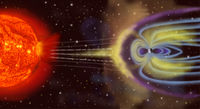
Photo from wikipedia
During geomagnetic storms rapid magnetic variations cause large, sharp enhancements of the magnetic and geoelectric field at mid‐latitudes. These present a potential hazard to grounded technology such as high voltage… Click to show full abstract
During geomagnetic storms rapid magnetic variations cause large, sharp enhancements of the magnetic and geoelectric field at mid‐latitudes. These present a potential hazard to grounded technology such as high voltage transformers, pipelines and railway systems. Spatiotemporal quantification can provide insight into the magnitude and configuration of their potential hazard. We use the Haar wavelet transform to localize in time and frequency the storm‐time response in both European ground‐based magnetometer measurements and modeled geomagnetically induced currents (GICs) from the high voltage grid of Great Britain (GB). Wavelet cross‐correlation of the GIC in the grounded nodes is then used to build a time‐varying network of GIC flow around the GB grid during storms including the 2003 Halloween storm. We find a highly intermittent (few tens of minutes duration) long‐range coherent response that can span the entire physical grid at most intense times. The spatial pattern of response seen in the GIC flow network does not simply follow that of the amplitude of the rate of change of B field. Coherent response is excited across spatially extended clusters comprised of a subset of nodes that are highly connected to each other, with a tendency for east‐west linkages following that of the physical grid, simultaneous with the overhead presence of the auroral electrojet and the inducing component of the magnetic field. This can quantify the spatial and temporal location of increased hazard in specific regions during large storms by including effects of both the geophysical and engineering configuration of the high voltage grid.
Journal Title: Space Weather
Year Published: 2021
Link to full text (if available)
Share on Social Media: Sign Up to like & get
recommendations!